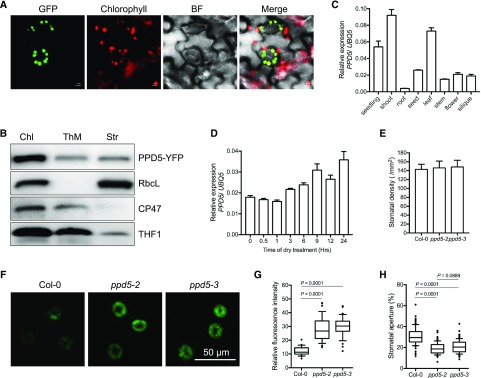Figure 2.
The mutations in PPD5 enhance stomatal closure via increasing H2O2 accumulation in guard cells. A, Subcellular localization of PPD5-YFP fusion protein in the guard cells of transgenic Arabidopsis seedlings harboring the PPD5pro:PPD5-YFP construct. Chlorophyll, autofluorescence of chlorophyll; BF, bright field. Bars = 5 μm. B, Immunoblot analysis of RbcL, CP47, THF1, and PPD5 in fractionated chloroplast proteins. Chl, whole chloroplast; ThM, thylakoid membrane; Str, stromal fraction. C, The expression pattern of PPD5 in Arabidopsis. Values are means ± sd (n = 3). D, The expression levels of PPD5 in 21-d-old plant leaves treated with air dry. Values are means ± sd (n = 3). E, Stomatal density in the middle leaves of 4-week-old ppd5-2, ppd5-3, and Col-0. F, Representative images of the CM-H2DCFDA staining of H2O2 in guard cells of ppd5-2, ppd5-3, and Col-0 leaves of 21-d-old plants after a 5-d drought stress treatment. G, Quantitative measurement of H2O2 levels in guard cells of ppd5-2, ppd5-3, and Col-0 (n = 90, stomata from 21-d-old plants after drought stress for 5 d). H, Stomatal apertures of the middle leaves of 3-week-old ppd5-2, ppd5-3, and Col-0 plants after drought treatment for 5 d (n ≥ 80). Stomatal aperture was calculated by the percentage of width/length ratio. P-value was determined by Student’s t test.

